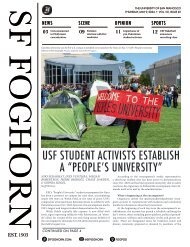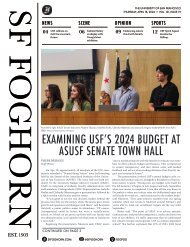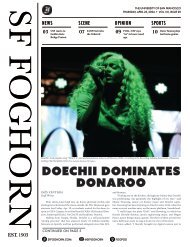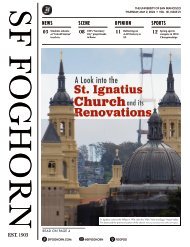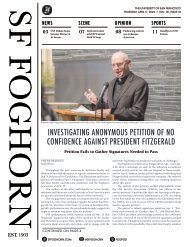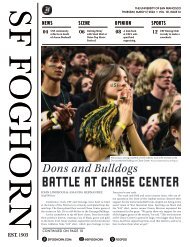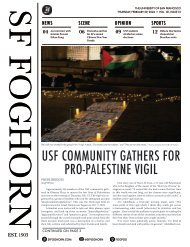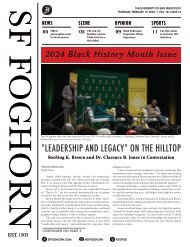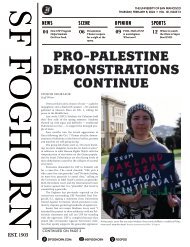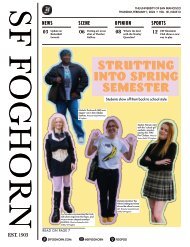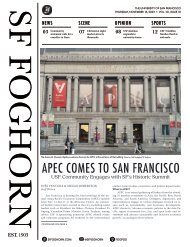FOGHORN ISSUE 9 FINAL
You also want an ePaper? Increase the reach of your titles
YUMPU automatically turns print PDFs into web optimized ePapers that Google loves.
SF <strong>FOGHORN</strong><br />
NEWS<br />
04<br />
Senate hosts<br />
town hall in<br />
new format.<br />
SCENE<br />
07<br />
USF attends the<br />
American Indian<br />
Film Festival.<br />
THE UNIVERSITY OF SAN FRANCISCO<br />
THURSDAY, NOVEMBER 9, 2023 • VOL. 121, <strong>ISSUE</strong> 9<br />
OPINION<br />
09<br />
Why the Land<br />
Back movement is<br />
integral for all.<br />
SPORTS<br />
12<br />
Men’s Basketball<br />
beats Bethesda by<br />
69 points.<br />
Much of Yolanda López’s work frames her mother and her grandmother (depicted above) in the spotlight. Photo by Samantha Avila Griffin/SF Foghorn.<br />
“ WOMEN’S WORK IS NEVER DONE “<br />
EXPLORES ACTIVISM THROUGH ART<br />
MEGAN ROBERTSON<br />
Staff Writer<br />
The Virgin of Guadalupe is a symbol that is imbued in<br />
the very essence of Catholicism in North and South America.<br />
Her hands in prayer, the young woman radiates a divine,<br />
golden glow. This apparition of Mary, the virginal mother<br />
of Jesus, is one of the most prominent symbols in American<br />
Catholicism.<br />
Many Catholics would consider it sacrilegious to manipulate<br />
the Virgin of Guadalupe in any way — and in 1978<br />
with her famous, artistic motifs of Guadalupe, San Francisco<br />
artist Yolanda M. López did just that.<br />
CONTINUED ON PAGE 6<br />
Thacher Gallery’s current exhibition, “Women’s Work is<br />
Never Done,” shares the life work of López (1942-2021), the<br />
longtime San Francisco resident, artist, Chicanx and Latinx<br />
activist. The gallery opened the exhibition on Aug. 31.<br />
Curated by López’s son Rio Yañez and artist Angelica<br />
A. Rodriguez, the exhibition features work from López’s<br />
60-year-long career. It includes some of her most famous<br />
works, such as her 1978 “Guadalupe: Woman Goddess,” and<br />
her 1990s political poster artwork, in addition to pieces that<br />
were discovered after her death in Sept. 2021, like her 1974<br />
portrait of her mother.<br />
EST. 1903<br />
SF<strong>FOGHORN</strong>.COM<br />
@SF<strong>FOGHORN</strong><br />
FOGPOD
02 03<br />
THURSDAY<br />
NOV. 9<br />
2023<br />
STAFF<br />
Editor in Chief<br />
MEGAN ROBERTSON<br />
mrrobertson2@dons.usfca.edu<br />
News Editor<br />
NIKI SEDAGHAT<br />
nisedaghat@dons.usfca.edu<br />
Opinion Editor<br />
CHISOM OKORAFOR<br />
cokorafor@dons.usfca.edu<br />
Scene Editor<br />
JORDAN PREMMER<br />
jepremmer@dons.usfca.edu<br />
Sports Editor<br />
CHASE DARDEN<br />
cbdarden@dons.usfca.edu<br />
Photography Online Editor Editor<br />
LEILA ESHA TSELNER DUPUGUNTLA<br />
latselner@dons.usfca.edu<br />
ekdupuguntla@dons.usfca.edu<br />
General Reporter<br />
JORDAN TYLER MARALIT<br />
jcmaralit@dons.usfca.edu<br />
General Reporter<br />
JOR 415.422.5444<br />
DAN sffoghorn.com TYLER MARALIT<br />
jcmaralit@dons.usfca.edu<br />
SUBMISSION POLICY<br />
The San Francisco Foghorn is the<br />
official student newspaper of the<br />
University of San Francisco and<br />
is sponsored by the Associated<br />
Students of the University of San<br />
Francisco (ASUSF).<br />
The thoughts and opinions<br />
expressed herein are those of the<br />
individual writers and do not<br />
necessarily reflect those of the<br />
Foghorn staff, the administration,<br />
the faculty, staff or the students of<br />
the University of San Francisco.<br />
Contents of each issue are the sole<br />
responsibilities of the editors.<br />
An All-American<br />
Publication<br />
ad maiorem dei<br />
gloriam<br />
The San Francisco Foghorn is free<br />
of charge.<br />
Advertising matter printed herein<br />
is solely for informational purposes.<br />
Such printing is not to be construed<br />
as written or implied sponsorship<br />
or endorsement of such commercial<br />
enterprises or ventures by the San<br />
Francisco Foghorn.<br />
©MMIV-MMV, San Francisco<br />
Foghorn. All rights reserved. No<br />
material printed herein may be reproduced<br />
without prior permission<br />
of the Editor in Chief.<br />
SAN FRANCISCO<br />
<strong>FOGHORN</strong><br />
Freedom and Fairness<br />
Managing Editor<br />
JORDAN DELFIUGO<br />
jgdelfiugo@dons.usfca.edu<br />
Copy Editor<br />
INÉS VENTURA<br />
ipventura@dons.usfca.edu<br />
Layout Editor<br />
AVA LORD<br />
ajlord@dons.usfca.edu<br />
Layout Editor<br />
ANYA JORDAN<br />
arjordan@dons.usfca.edu<br />
Social Media Manager<br />
MARIA ZAIED<br />
mfzaied@dons.usfca.edu<br />
ADVISOR<br />
TERESA MOORE<br />
2130 FULTON STREET, UC #417<br />
SAN FRANCISCO, CA 94117<br />
Columns for the Opinion section<br />
and Letters to the Editor are gladly<br />
accepted from students, faculty, staff<br />
and alumni.<br />
All materials must be signed and<br />
include your printed name, university<br />
status (class standing or title),<br />
address, and telephone number for<br />
verification. Anonymous submissions<br />
are not published.<br />
We reserve the right to edit materials<br />
submitted. All submissions<br />
become the property of the San<br />
Francisco Foghorn.<br />
Staff editorials are written by the<br />
Foghorn editorial staff and represent<br />
a group consensus.<br />
The San Francisco Foghorn Opinion<br />
page is a forum for the free, fair and<br />
civil exchange of ideas. Contributors’<br />
opinions are not meant to<br />
reflect the views of the Foghorn staff<br />
or the University of San Francisco.<br />
Students interested in contributing<br />
to the Foghorn can scan and fill out<br />
the QR code below.<br />
STAFF EDITORIAL<br />
MORE THAN A MYTH: THE VALUE<br />
OF INDIGENOUS KNOWLEDGE<br />
For centuries, the realm of<br />
“valid” knowledge has excluded many<br />
perspectives, often to its own detriment.<br />
However, in the past few years,<br />
academic institutions and world governments<br />
are finally recognizing the<br />
value of alternative sources of information.<br />
Indigenous Knowledge is a<br />
valid form of expertise, and institutions<br />
should further their efforts in<br />
embracing it.<br />
Indigenous Knowledge is defined<br />
as “understandings, skills, and<br />
philosophies developed by local communities<br />
with long histories and experiences<br />
of interaction with their<br />
natural surroundings,” according<br />
to UNESCO’s programme on Local<br />
and Indigenous Knowledge Systems.<br />
Though Indigenous knowledge can<br />
come in different forms, the International<br />
Encyclopedia of Human Geography<br />
notes that Indigenous Knowledge<br />
is “characteristically local in<br />
scale, transmitted orally, collectively<br />
owned, holistic in perspective, and<br />
adaptive in nature.”<br />
Western institutions’ preference<br />
for written sources have historically<br />
led to the discounting of oral Indigenous<br />
Knowledge, as detailed by the<br />
Oral History Association. Western<br />
scholars have jumped to assume Indigenous<br />
oral history is simply myth,<br />
with no basis in reality. In 1917, Robert<br />
Lowie wrote in the Journal of<br />
American Folklore that “Indian tradition<br />
is historically worthless.” In<br />
reality, the Oxford Academic finds,<br />
“Indigenous oral histories are not<br />
merely traditions, myths, chants, or<br />
superstitions, but are valid historical<br />
accounts passed on vocally in various<br />
forms, forums, and practices.” These<br />
oral accounts are as reliable as other<br />
methods.<br />
For example, the Yale Law Journal<br />
details an infamous legal battle<br />
from 1996-2004 between Western<br />
scientists and five Indigenous nations<br />
of the Columbia Plateau. The<br />
Bonnichsen v. United States case regarded<br />
the body of an ancient human<br />
referred to as the “Kennewick Man”<br />
that scientists claimed had no relations<br />
to modern day Indigenous peoples.<br />
Initially, the courts sided with<br />
the scientists, in part because they<br />
dismissed the oral tradition evidence<br />
presented by the nations due to “concerns<br />
of authenticity, reliability, and<br />
accuracy.” However, DNA evidence<br />
revealed that the Kennewick man was<br />
indeed related to Indigenous Americans.<br />
This trial proved that not only<br />
is Indigenous Knowledge reliable, it is<br />
also capable of reaching conclusions<br />
faster than Western methodologies.<br />
Another positive impact of Indigenous<br />
Knowledge is the refutation<br />
of the idea that before colonization,<br />
land was “untamed”. Academics are<br />
realizing that the American frontier<br />
that was once considered wild<br />
are actually products of generations<br />
of careful cultivation by Indigenous<br />
peoples, such as the prairies of the<br />
midwest that were subject to centuries<br />
of systemic controlled burning to<br />
become the rolling hills of today.<br />
These examples have put an end<br />
to the pessimistic idea that coexistence<br />
between humans and nature is<br />
impossible. Humans have, and will<br />
continue to, influence the natural<br />
world in positive ways that cultivate<br />
flourishing environments.<br />
Indigenous knowledge is passed<br />
down through teachings, not biologically<br />
acquired, and is born out of a<br />
history of studying the environment<br />
and one’s relation to it. Indigenous<br />
Knowledge doesn’t fall under the<br />
common “Magical Native American”<br />
trope in popular culture that portrays<br />
Indigenous people as inherently<br />
more spiritual and “close to nature”<br />
than others. Indigenous knowledge<br />
is not ubiquitous, as even just within<br />
the U.S. there are countless distinct<br />
and vibrant Indigenous nations.<br />
In recent years, more and more<br />
Western institutions are recognizing<br />
the value of Indigenous Knowledge.<br />
The Biden Administration has “formally<br />
recognized Indigenous Knowledge<br />
as one of the many important<br />
bodies of knowledge,” following the<br />
Canadian Government, just to name<br />
a few.<br />
In the course of righting the<br />
wrongs of history, the incorporation<br />
and valuation of non-Western perspectives<br />
and ways of thinking is crucial<br />
to solve the problems facing the<br />
world today. Indigenous knowledge is<br />
a credible source, and should be embraced<br />
in Western institutions.<br />
ASUSF SENATE HOSTS<br />
FIRST TOWN HALL OF THE YEAR<br />
KYLEY FISHMAN<br />
Contributing Writer<br />
The Associated Students of the University of San Francisco<br />
(ASUSF) Senate hosted its Fall 2023 Town Hall on Nov. 1 in McLaren<br />
Conference Center. The town hall was restructured this semester<br />
to give USF community members an opportunity to address their<br />
concerns in a small, group-oriented discussion, directly with an<br />
administrator, led by an ASUSF Senate appointed facilitator of the<br />
table.<br />
Historically, town hall meetings were led by administrators<br />
and members of the Senate. They would consist of an hour-long<br />
presentation, conducted by administration, followed by student’s<br />
questions.<br />
According to ASUSF Senate’s Vice President of Internal Affairs,<br />
Kiannah-Nicole Karani, who is also a sophomore environmental<br />
studies major, town halls “happen<br />
once a semester, but it’s the first<br />
truly student focused one.”<br />
This semester’s town hall<br />
focused on food and housing. When<br />
students walked into McLaren, they<br />
were met with five tables placed<br />
throughout the room, each with<br />
a placard displaying the table’s<br />
designated topic. Students were then<br />
encouraged to sit at the table they<br />
felt most aligned with their concern.<br />
Senate facilitators led students<br />
and administration in a moderated<br />
discussion over the student’s<br />
concerns. Topics ranged from food<br />
quality of on-campus dining to<br />
housing accessibility.<br />
Junior english major Sarah<br />
Badawi attended the town hall<br />
because of her struggle with finding<br />
off-campus housing. “I felt like the<br />
administration seated at the table<br />
were actively listening and taking<br />
notes,” said Badawi. “They gave<br />
examples of where to go and events<br />
to attend in case we wanted to know<br />
more or if we had any other issues.”<br />
ASUSF Senate’s new town<br />
hall format is designed as a way<br />
to allow concerns to be vocalized<br />
and responded to, one-on-one with<br />
students and administration.<br />
“I love it,” said Mariah Moore,<br />
a first-year English major and the<br />
Resident Hall Council President for<br />
Gillson Residence Hall. “I love that<br />
it’s an outlet for students to be heard<br />
and voice their concerns because I<br />
feel like there’s not enough avenues<br />
for students to do that besides the<br />
few surveys the University pushes<br />
out. I feel like that’s not enough. You<br />
need somewhere where students can<br />
physically go and voice their concerns. So I think this is great.”<br />
Tori Broillard-Bruce, Senior Director for Student Housing, said,<br />
“I’ve really appreciated this switch into this format.” “The town hall<br />
forum style really creates a better suited, conversational, direct<br />
approach to talking about the key issues that we [in administration]<br />
need to take care of…Sometimes, we’re not doing what we need to do<br />
because we don’t know what we need to do.”<br />
He encourages students to directly contact administrators,<br />
facility, or residence hall leaders regarding issues through email,<br />
phone, or by going to an administrator’s office, as they will get<br />
resolved in a more timely manner.<br />
“Community is nothing more than unity through communication,<br />
and the more communication we can have, the more community we<br />
can have because we have that unity,” Brouillard-Bruce concluded.<br />
The next town hall will be on Mar. 6, 2024, from 5 p.m. - 7 p.m.,<br />
with topics and location TBD.<br />
This semester’s town hall centered on issues pertaining to food and housing, with five different tables.<br />
Photo by Samantha Avila Griffin/SF Foghorn.<br />
NEWS
04 05<br />
THURSDAY<br />
NOV. 9<br />
2023<br />
USF REACTS TO SAN FRANCISCO<br />
TRANSPORTATION NEWS<br />
JORDAN DELFIUGO<br />
Staff Writer<br />
JOIN THE <strong>FOGHORN</strong><br />
Revel previously suspended moped operations in Washington, D.C. last<br />
November. Screenshot from @gorevel on Instagram<br />
Revel Pulls Mopeds<br />
After a five year run, the electric rideshare company, Revel announced<br />
that it will be decommissioning its fleet of 3,000 mopeds in San Francisco<br />
and New York City, effective Nov. 18. The plan was announced via a Nov.<br />
3 company wide email, in which Revel CEO and co-founder, Frank Reig,<br />
stated that Revel would discontinue the moped service. According to the<br />
San Francisco Chronicle, the decision comes following a 30% decline in<br />
ridership. Sophie Fudge, sophomore nursing major, said she will miss<br />
Revel. “I think its always unfortunate when there’s one less alternative<br />
method of transportation to get around the city, especially something<br />
like a moped, which is very convenient in San Francisco.” She continued,<br />
“I thought they were a good time, they definitely had a use. I’m sorry<br />
to see them go, especially since they were electric.” In a statement to<br />
The San Francisco Standard, Revel spokesperson Robert Familiar said<br />
that the company would be shifting its focus towards “electric car ridehailing<br />
and charging” moving forward.<br />
NEWS<br />
Check SFMTA.com for the latest updates and alternate routes during road<br />
closures.. Screenshot from @sfmta_muni on Instagram<br />
Despite an estimated 15,000 car break-ins, there have only been 45<br />
convictions as of September, according to District Attorney Brooke Jenkins.<br />
Photo courtesy from @SFCarBreakins on X.<br />
APEC Prompts Road Closures<br />
Road closures and local traffic restrictions will occur Nov. 7th<br />
through Nov. 18th due to the Asian-Pacific Economic Cooperation<br />
(APEC) summit, according to the San Francisco Municipal<br />
Transportation Agency’s website. The annual APEC summit event,<br />
occurring between Nov. 11 and Nov. 18 which will be hosted at the<br />
Moscone Center in downtown San Francisco, is expected to host over<br />
20,000 attendees from 21 different countries, Kron reported. President<br />
Joe Biden and China’s president, Xi Jinping, are among those expected<br />
to attend, according to the San Francisco Chronicle. Road closures and<br />
detours will surround the Moscone Center and Yerba Buena Gardens,<br />
affecting parts of Mission Street, Market Street, and California Street<br />
to name a few. There will also be pedestrian checkpoints at various<br />
locations, including at Howard Street, Mission Street, Folsom Street,<br />
and Huntington Park. Nikki Thomas, a junior psychology major, said,<br />
“It’s pretty crazy that San Francisco is hosting this event, but I can’t say<br />
I’m looking forward to [the closures]. It’s already hard enough to get<br />
around SF without detours and checkpoints too.”<br />
New Car Break-in Legislation<br />
According to San Francisco District Attorney Brooke Jenkins,<br />
there have been approximately 15,000 car break-ins in San Francisco<br />
this year. On Oct. 26, Senator Scott Wiener held a press conference<br />
at the Palace of Fine Arts, where he introduced new legislation which<br />
aims to close a “legal loophole” that Wiener suggests complicates the<br />
process of prosecuting car break-ins when they occur. The legislation<br />
would eliminate the “open door defense,” which requires prosecutors<br />
to prove beyond a reasonable doubt that one’s car door was locked at<br />
the time of the break-in to convict for auto burglary, the San Francisco<br />
Standard reported. George Condes, a junior computer science major,<br />
said “I’ve seen lines of smashed car windows at touristy places in the<br />
city. I’m shocked that this defense existed to begin with, but glad it<br />
might be changing.” At the press conference, Wiener said that he plans<br />
to introduce the bill in January when the legislature reconvenes, in<br />
hopes that it will be signed into law by the end of 2024.<br />
The Fall 2023 staff of the Foghorn wants you to join us! Photo by Student Leadership and Engagement/USF.<br />
We have six open positions for Spring 2024:<br />
News Editor<br />
Scene Editor<br />
Copy Editor<br />
Layout Editor<br />
General Assignment Reporter<br />
Deputy Writer<br />
Come work for the Foghorn! Please email<br />
mrrobertson2@dons.usfca.edu and jgdelfiugo@dons.usfca.edu<br />
for information on the position requirements and application<br />
process. Applications are due Friday Dec. 1 at 12 a.m.
06 CONTINUED FROM FRONT PAGE<br />
07<br />
THURSDAY<br />
NOV. 9<br />
2023<br />
SCENE<br />
On Nov. 6, co-sponsored with the Spanish Studies department, Karina<br />
Hodoyán, professor of Latinx and Chicanx Studies, led approximately<br />
two dozen students and community members on a tour of<br />
the exhibition framing López’s work in the context of San Francisco<br />
social movements.<br />
“She transformed the way that Latinx and Chicanx scholars<br />
talk about the production of culture, talk about the legacy of history,”<br />
Hodoyán said. “The art not only was beautiful but also offered<br />
a message.”<br />
The gallery was divided into decades of her artistry, spanning<br />
from the 1960s to the 2000s. Some of the earliest featured artwork<br />
was inspired by López’s political advocacy in the Mission District,<br />
using activist mobilizing techniques she learned from the Black<br />
Panther Party. Her 1969 work, “Free Los Siete,” depicts the stripes<br />
of the American flag as a jail cell, imprisoning members of “Los Siete<br />
de la Raza,” a group of seven Latine young adults who were tried<br />
in 1969 for the death of a police officer.<br />
Rain Longoria, a first year environmental science major who<br />
attended the tour, said she was most moved by López’s “Las Santas<br />
Locas” 1979 photography series, in which López centers the all-female,<br />
Mission District-based car club.<br />
In the tour, Hodoyán noted how these women were often<br />
“criminalized and misrepresented in the media.” Hodoyá argued<br />
that López’s photography changed the narrative, representing “joy<br />
and empowerment” in the women’s “sacred power and femininity.”<br />
Initially, Longoria said she did not recognize the significance<br />
of what ended up being her favorite work in the exhibition. “I was<br />
just like, ‘oh, it’s like a beautiful picture of her and her friends.’…<br />
Yolanda López’s “The Nanny” makes its second appearance at USF’s Thacher Gallery this fall, after being featured in the<br />
2019-2020 show “Emboldened, Embodied.” Photo by Samantha Avila Griffin/SF Foghorn.<br />
No — it’s us becoming goddesses.”<br />
Frank Nuñez attended Monday’s tour with their partner, USF<br />
alum Somer Tiller. Being from López’s hometown of San Diego,<br />
Nuñez said, “It was really nice to see the representation, the transition<br />
from San Diego to San Francisco, which is what I’ve done…And<br />
the more modern representation of Latinx artists.”<br />
Nuñez’s favorite work in the exhibition was López’s 1994 “The<br />
Nanny.” As opposed to her typical work, which is based in photography,<br />
painting, and multimodal collages, “The Nanny” offers a lifesized,<br />
traditional nanny uniform. Indigenous religious symbols, the<br />
Virgin of Guadalupe, and a fetus are painted on the garment, along<br />
with a baby bottle and a corn husk sticking out of the pockets.<br />
While this is Thacher’s first exhibition of López’s entire body<br />
of work, “The Nanny” was featured in the gallery’s 2019-2020 show<br />
“Emboldened, Embodied.”<br />
Thacher Gallery planned to showcase a full body of López’s<br />
work after her involvement in the 2019-2020 show. However, due<br />
to the COVID-19 pandemic and López’s passing, the gallery is just<br />
now sharing a full embodiment of her work.<br />
Tiller worked at the gallery on “Emboldened, Embodied,” which<br />
inspired them to return for this exhibition. “It felt good to see her<br />
whole body of work and just like not a few pieces,” Tiller said. “It<br />
really gave me a lot of perspective about her and her life.”<br />
“The Nanny” is part of López’s titular series featured in the<br />
exhibition, “Women’s Work is Never Done.”<br />
Also under this motif are López’s silkscreen prints, the<br />
1996“From South Africa to North America,” which displays two<br />
women from both locations with a protest scene in the exterior,<br />
and her 1997 “Your Vote Has Power,”<br />
which displays a woman of color<br />
voting with a child on her back.<br />
“I feel like her work is very contemporary,”<br />
said Gloria Simmons,<br />
Director of Thacher Gallery. “Even<br />
the things that she made in the sixties<br />
— the protest posters — they<br />
are responding to things that we’re<br />
responding to now.”<br />
“Your Vote Has Power” is also<br />
reflected on one of López’s “pocket<br />
posters.” These polaroid sized<br />
images are sent home with gallery<br />
attendees. With her artwork on<br />
the front and a call to action on<br />
the back, the idea of pocket posters<br />
has been a staple of López’s artistry<br />
throughout her career. “Your Vote<br />
Has Power”’s call to action reads:<br />
“The practice of citizenship destroys<br />
the illusion of Whiteness…<br />
The treasure you own is your vote.<br />
Most politicians covet it and fear<br />
how you will use it….Seize the<br />
time.”<br />
Since August, exhibition tours<br />
have ended with USF community<br />
members making their own pocket<br />
posters, which are now on display<br />
in the gallery. Some read: “no<br />
human is illegal,” “Is brown skin a<br />
crime?” and “Freedom starts with<br />
free minds.”<br />
“Women’s Work is Never Done”<br />
will remain on display until Nov. 12.<br />
Thacher Gallery’s next exhibition,<br />
“Offerings Somatic—the body as a<br />
substance of ritual,” will open on<br />
Nov. 30 and close on Feb. 18, 2024.<br />
USF CULTURAL CENTERS LEADS FIELD<br />
TRIP TO AMERICAN INDIAN FILM FESTIVAL<br />
ELINA GRAHAM<br />
Staff writer<br />
Applause and cheers filled San Francisco Public Library’s<br />
Screening Room on Nov. 4, as the second day of the “American Indian<br />
Film Festival” concluded. The American Indian Film Institute,<br />
founded in 1979 began the festival as a means to foster “understanding<br />
and appreciation of the culture, traditions, and issues”<br />
that Native American still experience today, according to their mission<br />
statement.<br />
Now in its 48th year, the festival held screenings of 56 films<br />
from Nov. 3–11th at various Bay Area locations, including the De<br />
Young Museum, Berkeley City College, and the California Academy<br />
of Sciences. Ranging from documentaries, to animations and music<br />
videos, all films were works made by and about Native American,<br />
Alaskan Native, and Canada First Nation peoples. Each day of the<br />
festival, a number of films were shown so viewers had the option to<br />
plan their visit around what they wanted to see.<br />
USF’s Cultural Centers hosted a field trip on Nov. 4 to attend<br />
the Animations Program screening at San Francisco Public Library’s<br />
Main branch. “To have these events is to embrace more and<br />
more diversity in the city,” said sophomore computer science major,<br />
Ezequiel Beck, who attended the trip. “It’s important for these<br />
events to happen, and to invite students to come and learn.”<br />
Assistant Director of USF’s Cultural Centers D. Perez Sornia<br />
emphasized the relevance of attending city-initiated cultural<br />
events. “I think the city putting their money where their mouth is<br />
by uplifting events happening all around us is great. It’s a way for us<br />
to stand with communities who we aren’t personally a part of, and a<br />
Speaker Mary Jean Robertson has been amplifying native voices for 50 years on her KPOO radio program, Voices of<br />
the Native Nations. Screenshot from @AIFISF on Instagram.<br />
way of giving them opportunities to tell their stories.”<br />
Some films explored the longstanding history of violence and<br />
racism against Indigenous people. One film, “Ohskennón:ten Owí:ra<br />
(Little Deer),” showed two Indigenous girls’ escape from the abuse<br />
and horror they experienced at the Mohawk Institute Residential<br />
School. This was one of many schools established by Christian missionaries<br />
and the U.S. government to eradicate Indigenous Culture<br />
and forcefully assimilate Native American youth into mainstream<br />
American society.<br />
Mohawk writer and director Jonathan Elliot of the Six Nations<br />
Reserve in Ontario took to the stage to introduce his film “Ohskennón:ten<br />
Owí:ra (Little Deer).” “I don’t consider this my story,<br />
I consider it a community story. The survivors told me they wanted<br />
to make this film to educate audiences about what they went<br />
through at residential schools, but to make it a message of hope<br />
and resilience.” Elliot said, on the film’s significance. “I think it’s a<br />
testament to their strength and to their ability to help guide future<br />
generations to understand what they went through, because it’s important<br />
to not forget.”<br />
USF Graduate student Yih Ren, who is the Gender and Sexuality<br />
Center Coordinator at the USF Cultural Centers, attended<br />
the festival and spoke on the impact storytelling has on our understanding<br />
of the people around us. “Oftentimes when we talk about<br />
representation, we’re talking about only one type for a whole culture<br />
or ethnicity, so if we add more stories, we add more layers to<br />
that representation.”<br />
Screenings will continue until Nov. 11th both virtually and<br />
in person, at venues throughout Berkeley and San Francisco<br />
— information about tickets can be found on their website.<br />
SCENE
08 09<br />
THURSDAY<br />
NOV. 9<br />
2023<br />
OPINION<br />
THE DONS BAND BOUNCES BACK<br />
JORDAN MARALIT is a<br />
junior politics major.<br />
The Importance of Arts Revitalization Post-COVID<br />
At the start of my freshman<br />
year, I was looking for ways to<br />
get involved on campus when I<br />
stumbled upon a club called the<br />
“USF Dons Band” at the Involvement<br />
Fair. As someone who tapped into<br />
their musical talents at the age of<br />
seven, when I first played the piano,<br />
the band seemed like the perfect<br />
way for me to partake in a campus<br />
activity, and continue to explore my<br />
interest in music.<br />
Having a marching band in<br />
college allows students to bolster<br />
their musical self-expression. The<br />
band has helped me to express<br />
myself and step out of my comfort<br />
zone artistically. It is important<br />
because college students may have a difficult time finding their<br />
crowd and interests.<br />
Despite all the benefits it brings, the Dons Band has faced many<br />
challenges, which led to a decline in enrollment during and after<br />
the COVID pandemic. According to the USF Dons Band website,<br />
the team has a 30-player capacity, but since COVID, membership<br />
has declined. This year, there are only 12 active members. When the<br />
COVID lockdowns started in March 2020, the Dons Band were at<br />
the West Coast Conference Tournament in Las Vegas. They returned<br />
to USF right after, and then, along with the rest of USF, all members<br />
engaged in remote learning, according to the band’s director and<br />
adjunct professor Joseph Lares, who founded the Dons Band in 2009.<br />
When USF went fully remote, it was difficult for organizational<br />
in-person activities — like band rehearsal — to take place. According<br />
to the National Endowment for the Arts, few areas of the U.S economy<br />
were hit harder than the performing arts. This was especially true on<br />
college campuses.<br />
Lares said, “Members graduated, recruitment dwindled, and by<br />
Fall 2021 the band was only down to eight members. It was unclear<br />
if we would be able to rebound from the pandemic, but with a core<br />
of student officers still operating over Zoom wanted to relaunch the<br />
band.”<br />
Despite difficulties, the band persevered and continued to rebuild<br />
as a club. While meeting on Zoom, the Dons Band created a “Stayat-Home<br />
Project” with band members altogether and performed a<br />
rendition of “San Francisco” by Judy Garland.<br />
To truly bring the band to its full level again, we must rebuild<br />
what has been lost: by bringing more people together and sharing a<br />
common love for performing arts.<br />
The Dons band amplifies school spirit through athletic events,<br />
Halloween block parties, and competitions against other bands. The<br />
main catalog of their music setlist varies through all music genres.<br />
It includes hits from Bruno Mars, Daft Punk, Otis Redding, the Foo<br />
Fighters, and traditional marching band repertoire.<br />
Not only is this a club that students of all skill levels can sign up<br />
for, but the Performing Arts and Social Justice Department offers the<br />
band as a course for a max of two credits.<br />
As a course, the band meets in the War Memorial Gym every<br />
Monday. The musicians split up into sectionals and divide the<br />
ensemble into groups — brass, woodwinds, and percussion — to<br />
practice their parts. A section leader is assigned to a particular group<br />
to supervise them, and guide the musicians through parts they may<br />
struggle with.<br />
Junior band member, and computer science major, Zachary Alon<br />
said that he joined the band because of his “desire to perform and to<br />
improve his skills as a musician.” Alon plays the alto saxophone.<br />
Alon, the executive manager, said, “New members are the<br />
lifeblood of the band. I want people to know that the Dons band is not<br />
only a place to play music, but also a tight knit community.”<br />
With more in-person campus activities taking place, the Dons Band<br />
now has the opportunity to recover. Performing arts organizations<br />
got hit hardest in the pandemic, however the perseverance of staying<br />
active through virtual interaction allowed them to survive. Now, the<br />
Dons Bands is showing that there can be a further revitalization of<br />
creativity and community spirit.<br />
The Dons Band’s next major gig will be at the Chase Center<br />
Doubleheader on Nov. 26th. To join the Dons Band, follow<br />
@usfdonsband on Instagram or the official website for more info.<br />
In February, the Dons Marching Band (pictured above) played at the Chinese New Year Parade. Screenshot from @usfdonsband on Instagram.<br />
LAND BACK’S ROOTING FOR US ALL<br />
INÉS VENTURA is a<br />
sophomore media studies major.<br />
Over the course of the last few<br />
years, you have probably heard some<br />
form of land acknowledgement<br />
towards a specific nation or<br />
Indigenous group as the original<br />
caretakers and rightful owners of<br />
the area you find yourself in. To<br />
many, this might seem as the latest<br />
“woke ritual,” but it is actually a<br />
historical action that stems from a<br />
much larger movement.<br />
The Land Back movement<br />
is “organizing and sacrificing<br />
to get Indigenous lands back to<br />
Indigenous hands,” according<br />
to the NDN Collective. For<br />
Indigenous Americans in the<br />
Western hemisphere, the Land<br />
Back movement has been an ongoing struggle since 1492 when<br />
Christopher Columbus arrived in North America. For generations<br />
since then, Native Americans have been organizing to get their land<br />
back — sometimes by way of treaties between the U.S. and Indigenous<br />
nations — and have banded together to form a movement towards<br />
restoring their land sovereignty.<br />
Land Back became more broadly known after it circulated online<br />
in 2018 as a hashtag started by Arnell Tailfeathers, a member of the<br />
Kainai tribe of the Blackfeet Confederacy of Canada, who is credited<br />
with popularizing the term. The NDN collective, which started the<br />
contemporary relaunch of Land Back, views the movement as a means<br />
to bring organized movements together that are “working towards<br />
true collective liberation,” as stated in their campaign description.<br />
Respecting and reinstating Indigenous land sovereignty is an<br />
action that is important not only to the healing of Native Americans,<br />
but to the land itself — and the movement should<br />
be seen as such. On the surface, Land Back appears<br />
to only be about undoing the harm caused by<br />
colonialism that Native Americans still deal with<br />
today. In reality, it is an intersectional movement<br />
that has roots in other advocacy movements,<br />
like environmental justice, that affect everyone.<br />
The purpose of Indigenous people reclaiming<br />
land is not only to serve as a reparation for the<br />
generations of abuse and erasure brought on<br />
by colonialism, but to restore the relationship<br />
between humans and land, which has been<br />
interrupted and unbalanced — made obvious by<br />
the climate crisis. According to the movement’s<br />
manifesto, the human relationship with Earth<br />
is supposed to be “symbiotic and just,” which is<br />
why restoring land stewardship to Native tribes<br />
is crucial to the healing of Indigenous lineage<br />
and the land which we all share.<br />
Since its inception, the movement has<br />
sparked many conversations and contentions<br />
between Indigenous activists and politicians<br />
questioning if giving land ownership back to<br />
Native tribes, as opposed to government or<br />
private groups, is a good idea. The movement’s<br />
successes have proven that it is.<br />
In 2020, the Esselen tribe of Northern<br />
California purchased 1,200 acres of land near<br />
Big Sur,Calif., in collaboration with the state.<br />
After 250 years of absence, the tribe now resides<br />
in their rightful land and have since been able<br />
Graphic by Grace Tawatao / GRAPHICS CENTER<br />
to use it again for “educational and cultural purposes,” according to<br />
Esselen tribal leaders.<br />
In January of 2022, the Save the Redwoods League, which has<br />
been protecting Redwood Forests since 1918, released a statement<br />
announcing the transfer of 523 acres of forestland to the Sinkyone<br />
Council. Sam Hodder, chief executive of the league, said to the<br />
New York Times, “Fundamentally, we believed that the best way to<br />
permanently protect and heal this land is through tribal stewardship.”<br />
The land has since been renamed Tc’ih-Léh-Dûñ, meaning “Fish Run<br />
Place” in the Sinkyone language.<br />
The restoration of land stewardship to Indigenous peoples has<br />
proven to not only be possible, but beneficial to the land itself. A<br />
study from Grist, a climate focused media organization, showed that<br />
Indigenous-led resistance to fossil fuel projects in the U.S. and Canada<br />
has stopped an “amount of greenhouse gas pollution equivalent to at<br />
least one-quarter of annual U.S. and Canadian emissions.” Outside of<br />
the U.S., reclamation projects have shown the same success. Science<br />
Academics at Elsevier found that biodiversity in Indigenous-managed<br />
lands in Brazil, Australia, and Canada has proven equal to that in<br />
protected areas.<br />
It’s hard to tell what to expect from the movement moving<br />
forward, since many of their demands have been repeatedly met with<br />
opposition from policy makers in respective states of land that have<br />
yet to be reclaimed. But if there’s one thing that the movement and<br />
its supporters have proven, is that they won’t take no for an answer.<br />
It’s easy to generalize Land Back as something that only pertains<br />
to Native groups, and even view it as a threat to the comfort granted<br />
to us by colonialism. However, these inhabited lands are meant to<br />
be protected by humans, not exploited for our use. As we move into<br />
a future threatened by countless climate issues, this movement is<br />
something we should all be part of as global citizens, with Indigenous<br />
people leading the way to health and healing for themselves, us, and<br />
the Earth as a whole.<br />
OPINION
10 11<br />
THURSDAY<br />
NOV. 9<br />
2023<br />
USF’S TAEKWONDO CLUB GEARS<br />
UP FOR FIRST TOURNAMENT<br />
DONS PLAYER PROFILE:<br />
MARISSA VASQUEZ<br />
SPORTS<br />
JORDAN MARALIT<br />
Staff Writer<br />
While Dons Athletics have most notably shined through basketball,<br />
baseball, and soccer, the USF Taekwondo Club is representing the<br />
Hilltop on the mat with their kicks, hits, and punches.<br />
USF’s Taekwondo’s Club is gearing up to compete at UC Davis’<br />
annual Fall Open Tournament on Nov. 19, which will be the club’s first<br />
tournament of the semester.<br />
The USF Taekwondo Club practices on the semi-competitive<br />
level of taekwondo, which entails more physicality than traditional<br />
taekwondo.The club is a member of USA Taekwondo, the governing<br />
body of taekwondo for the U.S. Olympic Committee.<br />
Taekwondo is a traditional Korean Martial Art which involves<br />
not only kicking and punching techniques, but also teaches focus and<br />
self-discipline. According to the Olympics, all taekwondo matches<br />
“last over three rounds of two minutes each, with a one minute break<br />
between rounds.” The website explains that “the objective of each<br />
competitor is to score points by landing blows and kicks on their<br />
opponent’s torso or head or to win by knockout.”<br />
It is further described that “blows must be delivered through<br />
a straight punching technique using the knuckle part of a tightly<br />
clenched fist. The kicks that count are those delivered using any part<br />
of the foot below the ankle.”<br />
Brisbane Martial Arts describes the ranking of taekwondo belts<br />
as, “The first being white, which you receive when you commence<br />
training. The following belts are yellow, blue, red, red/black, Cho Dan<br />
Bo, black/white and black belt. On each of the color belts you wear<br />
stripes indicating your level of attainment on that belt.”<br />
The USF team participates in local tournaments such as the annual<br />
University of California Open Taekwondo Championships hosted at<br />
UC Berkeley and the American Open Taekwondo Championships held<br />
at California State University, East Bay.<br />
The club prepares students who wish to upgrade their belts and<br />
compete in major tournaments every semester. Junior kinesiology<br />
major and president of USF Taekwondo Club, Jake Gonzaga, currently<br />
has a third degree black belt.<br />
Gonzaga has competed nationwide and internationally. He has<br />
traveled to Mexico, Costa Rica, Taiwan, South Korea, among other<br />
nations to compete in world championships.<br />
“During training, we try our best to simulate the competition<br />
format and visualize what it will be like during the competition.<br />
Sparring requires a lot of stamina and strength so getting our bodies<br />
in shape is a top priority,” said Gonzaga.<br />
Taekwondo invites students from all experience levels to<br />
participate. Practices occur on Monday and Wednesday from 5-6:30<br />
PM at the Koret Combative room. If you are interested in joining, follow<br />
@usfca.tkd on Instagram and check out the Dons website for more<br />
information.<br />
Taekwondo club is open to students of all experience levels. Pictured left to right Yool Bong, Jake Gonzaga, Coach David Louis, Henry Delfino, Sean Paredes,<br />
and Kaitilyn Tran. Screenshot from @usfca.tkd on Instagram.<br />
ELISE GREEN<br />
Contributing Writer<br />
Marissa Vasquez started playing soccer when<br />
she was four years old. Now, a senior kinesiology<br />
major and awarded member of West Coast<br />
Confrence’s (WCC) 2022 All-Academic First Team,<br />
she’s the embodiment of her motivations.<br />
“I’ve always been so competitive,” she said. A<br />
native of Diamond Bar, Calif.,Vasquez said, “I did<br />
have some time where I didn’t play on a team, but<br />
I kept working and made it to college to play.” As<br />
WCC’s 2022 Offensive Player of the Week, her<br />
accolades have grown with her collegiate career.<br />
“If something doesn’t work there are other<br />
paths towards a goal,” Vasquez said. Regarding<br />
her journey to becoming a student athlete, she<br />
explained, “It’s what I’ve loved and grown through.”<br />
When Vasquez came to USF in 2020, she was<br />
a forward who had already received the WCC All-<br />
Freshman Honors. Three years later as a midfielder,<br />
having played and started all 19 games for the Dons<br />
last season, she said her perspective on what it’s<br />
like to be a student athlete has shifted.<br />
“Coming in as a freshman I was so nervous,”<br />
she admitted. Starting during the height of the<br />
COVID-19 pandemic, she called it “a unique,<br />
different experience,” but said she wouldn’t change<br />
a thing.<br />
Vasquez described balancing the sport with<br />
her education.“I think soccer helped me succeed in<br />
school,” she said. “I knew to keep playing my grades<br />
had to be good. [It] definitely taught me to have<br />
good time management.”<br />
Part of that time management goes to her<br />
game day routines, which includes grabbing game<br />
day tea lattes with her teammate, junior defensive<br />
player Isabelle Esparza. “Oat lavender Earl Grey<br />
for me and jasmine for Isa,” she said with a laugh.<br />
Whether it’s listening to relaxing music or finding<br />
time for a quick nap, Vasquez said that her routines<br />
contribute to her success on the field, and in the<br />
classroom.<br />
Vasquez reflected on her time playing soccer at<br />
USF. “I look back and think it’s crazy we’re already<br />
all seniors,” she said.“I’m way more confident and<br />
comfortable.”<br />
This past Saturday, Nov. 4, was the team’s last<br />
game of the season, away at Knoles Field against<br />
the Pacific Tigers —the same team Vasquez began<br />
her collegiate career against.<br />
“I always want to lead as an example,” she<br />
explained of the change she’s seen in herself from<br />
first-year to fourth. “Back then, and even now, I’m<br />
not the loudest on the field but I hope my game and<br />
effort speak for me and inspire my teammates and<br />
others around.”<br />
Marissa Vasquez has made a name for herself in women’s soccer within the West Coast Conference.<br />
Photo courtesy of Chris M. Leung/Dons Athletics.<br />
SPORTS
12<br />
THURSDAY<br />
NOV. 9<br />
2023<br />
Ndewedo “Chips” Newbury rises for the slam, pregame at War Memorial Gym. Photo courtesy of Chris M. Leung/Dons Athletics.<br />
DONS DOMINATE ON OPENING NIGHT<br />
SPORTS<br />
CHASE DARDEN<br />
Staff Writer<br />
The Dons Men’s Basketball Team opened up the 2023-24 season<br />
on Nov. 6, with a 128-59 win over Bethesda University.<br />
The Dons came out the gates firing, commanding a 50-point lead<br />
after one half of play. The Dons had an electric first half, shooting 13<br />
for 20 from three, and 73% from the field.<br />
Shining in their debuts were newcomers, Johnathan Mogbo and<br />
Mike Sharavajts.<br />
Mogbo finished with 17 points in his first game on the Hilltop.<br />
In the first half, Mogbo threw down multiple monstrous dunks and<br />
alley-oops that caused an eruption from the crowd, finishing with 15<br />
points in the first half. The junior Florida native transferred to USF<br />
this year, from Missouri State University where he spent his first two<br />
collegiate seasons.<br />
Mogbo reflected on his first performance on the Hilltop. “I brought<br />
energy, defense, everything. I feel like Coach [Gerlufsen] prepared us<br />
for this and I think everyone did a good job, on both sides,” he said.<br />
“I just want to thank God, without him nothing’s possible. My<br />
mom always told me when I get on the court to be ready. So just go out<br />
there, play hard, play as hard as you can, no matter who we are playing<br />
and good things will happen.”<br />
The Dons opened up the second half with a poster putback dunk<br />
by Sharavajts. The Dons made use of their entire team, with every<br />
player on the roster seeing time on the court, and with seven players<br />
scoring in double digits.<br />
Sharavajts, one of the Dons’ most highly anticipated transfers,<br />
held down the team as their starting point guard. The 6-foot-8 guard<br />
wasn’t scared of sharing the ball as he finished the game with 11 points,<br />
seven assists, and a highlight alley-oop that he threw to 7-foot-center<br />
Volodymyr Markovetskyy.<br />
Also adding to the barrage of offense for the Dons, was junior<br />
Stefan Todorovic, who put up 17 points, and showed his offensive<br />
skills, knocking down three three-pointers and shooting 7 for 11 from<br />
the field.<br />
Head Coach Chris Gerlufsen spoke on the newcomers’ impact on<br />
the game. “I think we have a lot of weapons up and down the lineup. I<br />
think we have guys where we could have multiple leading scorers as the<br />
year goes on,” he said.<br />
“Our newcomers have really meshed and ingrained themselves into<br />
our program quickly. They’re all exciting players… I’m excited about<br />
what our group can be. We’re not even close to what our potential is.”<br />
Todorovic also spoke about his successful shooting from behind<br />
the three-point line.<br />
“My whole life I’ve been a shooter, so I think it all comes with<br />
confidence, which I have all the time when I step on the court,” he said.<br />
“[Shooting is] my job. Be shot ready all the time, and being shot ready<br />
for me is going to open up a lot of different stuff for not only me but<br />
the others too.”<br />
Bethesda did not have much to show from their performance,<br />
shooting 37% from the field, 11% from three, and suffering 25<br />
turnovers — 15 more than the Dons. Bethesda only had one person<br />
score in double digits, Jonathan Ilelji, who put up 18 points. Ilelji shot<br />
1 for 8 from three, to go along with five turnovers.<br />
The Dons dominated the game, never letting Bethesda get the<br />
chance for a comeback. Throughout the length of the game, Bethesda<br />
never had a lead over the Dons.<br />
The Dons open up the new season undefeated, with a statement<br />
win that is bound to send a message to the rest of the West Coast<br />
Conference.<br />
Students can attend all Dons home games for free with the use of<br />
their One Card.




